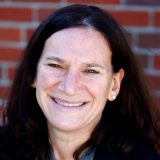According to Rabbi Jonathan Sacks z’l: “Sukkot is called, by tradition, zeman simchateinu, ‘our time of joy.’ That, to me, is the wonder at the heart of the Jewish experience: that Jews throughout the ages were able to experience risk and uncertainty at every level of their existence and yet they were still able to rejoice. That is spiritual courage of a high order. Faith is not certainty; faith is the courage to live with uncertainty. Faith is the ability to rejoice in the midst of instability and change, travelling through the wilderness of time toward an unknown destination.”
Our native Hebrew-speaking students who are new to our JCDS community exemplify a similar kind of courage every day. Coming to a brand new school as an English language learner (ELL) takes courage and a little bit of faith that, despite the initial discomfort and challenges, joy is around the corner! We are delighted that Rebecca Wangh has joined our faculty as our new ELL coordinator. Please enjoy the connections she has made between Sukkot and her work with our new students:
I am the coordinator and teacher of English language education at JCDS. This is a new department for our school, so I have been thinking a lot about the meaning of my role. I teach English to students new to the language and to the United States. But beyond what I teach, what does this role mean to our school? Shira and I decided that I would write about the English language learner (ELL) department in the context of Sukkot, and the more I explore this holiday, the more I see its connection to ELL.
Sukkot is the holiday of the open home, of hospitality and conviviality. When we celebrate Sukkot, we welcome guests, both rich and poor, into our space. The sukkah is an incomplete space, a structure that gives way to the stars, the rain, the view; it has a porous roof, and an open wall.
As an ELL teacher, I think about this holiday in the context of contemporary America. The United States struggles with the management of its borders, literally the walls and gates (airport gates) that let in or keep out new arrivals.
Most recently, we have heard the story of 50 South American immigrants who were put on flights to Martha’s Vineyard as a political stunt. This event is particularly vivid to me because, for the past two years, I worked as an ELL teacher in the Martha’s Vineyard public schools.
In the news, I read that among the newcomers were seven children. To me, this meant seven new English learners who might enter the Martha’s Vineyard public schools. I thought about how the ELL director would welcome them, how the interpreters would connect with their families, and how the teachers would bring them into their classrooms and school community. In the end, these newcomers moved on to other locations because the Vineyard community listened to them and responded to their needs.
Still, I know that those seven children will arrive in school this fall. I hope their teachers, particularly their ELL teachers, will greet with similar hospitality and conviviality. A classroom, after all, is like a community, or a country. It is both a real space and an ideal space, so we can imagine it like a sukkah. We designate the space of a sukkah with three walls and we decorate it, to make it beautiful and good. But unlike a house, we do not use it as protection (this is New England, after all!); we do not complete it with four walls. Rather, the sukkah is completed with the arrival of visitors and with the stories they bring.
Likewise, a classroom, a school, or a country is enriched with the arrival of newcomers, with the languages they bring and with the stories they will tell. I teach English so that we can understand each other’s stories, and my role as ELL coordinator is to keep our walls open and our imaginations as broad as the sky.
This post has been contributed by a third party. The opinions, facts and any media content are presented solely by the author, and JewishBoston assumes no responsibility for them. Want to add your voice to the conversation? Publish your own post here. MORE



